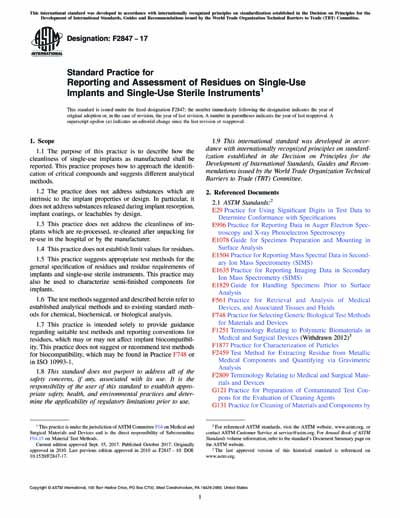Most recent
ASTM F2847-17
Standard Practice for Reporting and Assessment of Residues on Single-Use Implants and Single-Use Sterile Instruments
1.1 The purpose of this practice is to describe how the cleanliness of single-use implants as manufactured shall be reported. This practice proposes how to approach the identification of critical compounds and suggests different analytical methods.
1.2 The practice does not address substances which are intrinsic to the implant properties or design. In particular, it does not address substances released during implant resorption, implant coatings, or leachables by design.
1.3 This practice does not address the cleanliness of implants which are re-processed, re-cleaned after unpacking for re-use in the hospital or by the manufacturer.
1.4 This practice does not establish limit values for residues.
1.5 This practice suggests appropriate test methods for the general specification of residues and residue requirements of implants and single-use sterile instruments. This practice may also be used to characterize semi-finished components for implants.
1.6 The test methods suggested and described herein refer to established analytical methods and to existing standard methods for chemical, biochemical, or biological analysis.
1.7 This practice is intended solely to provide guidance regarding suitable test methods and reporting conventions for residues, which may or may not affect implant biocompatibility. This practice does not suggest or recommend test methods for biocompatibility, which may be found in Practice F748 or in ISO 10993-1.
1.8 This standard does not purport to address all of the safety concerns, if any, associated with its use. It is the responsibility of the user of this standard to establish appropriate safety, health, and environmental practices and determine the applicability of regulatory limitations prior to use.
1.9 This international standard was developed in accordance with internationally recognized principles on standardization established in the Decision on Principles for the Development of International Standards, Guides and Recommendations issued by the World Trade Organization Technical Barriers to Trade (TBT) Committee.
Content Provider
ASTM International [astm]






